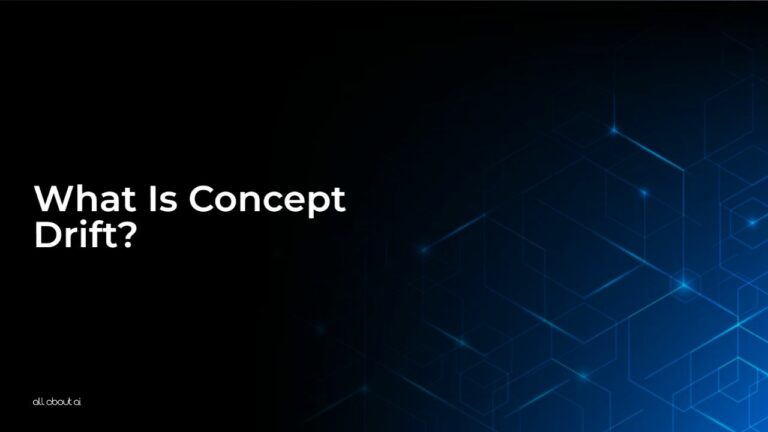What is concept drift? In the world of AI, concept drift refers to the phenomenon where the statistical properties of data used to train a machine learning model change over time, leading to a decrease in the model’s performance. This can occur due to various factors such as evolving user preferences, shifts in the underlying data distribution, or external changes in the environment. Concept drift poses a significant challenge in artificial intelligence as models that do not adapt to these changing conditions may become inaccurate and unreliable.
Looking to learn more about concept drift? Read this article written by the AI Connoisseurs at All About AI.
Examples of Concept Drift
Sentiment Analysis: Imagine a sentiment analysis model trained on social media data to classify posts as positive or negative. Over time, the meaning of certain words and phrases may evolve, making the model’s predictions less accurate.
Financial Fraud Detection: In the financial sector, fraud patterns constantly change. A fraud detection system trained on historical data and not on new, big data may struggle to detect new, emerging fraud techniques, resulting in increased financial risks.
Recommendation Systems: Online shopping platforms rely on recommendation algorithms to suggest products to users. As user preferences shift, models must adapt to ensure relevant recommendations, or they risk losing customer engagement.
Network Intrusion Detection: Cybersecurity systems using AI to identify network intrusions face evolving attack tactics. Adapting to new threat behaviors is crucial to maintaining network security.
Use Cases of Concept Drift
Autonomous Vehicles: Self-driving cars must adapt to changing road conditions, traffic patterns, and weather. Concept drift recognition helps these vehicles make real-time decisions to ensure passenger safety.
Medical Diagnosis: In the medical field, patient data can change over time as new symptoms emerge or conditions evolve. AI-driven diagnostic tools must continually adjust their knowledge to provide accurate diagnoses.
Stock Market Predictions: Predicting stock market movements requires AI models to account for changing market dynamics, news events, and investor sentiments, all of which exhibit concept drift.
Natural Language Processing: Language evolves, and AI applications such as chatbots and virtual assistants must adapt to the changing ways people communicate to maintain effective interactions.
Pros and Cons
Pros
- Models have the ability to recognize and adapt to concept drift, allowing them to maintain high accuracy even in rapidly changing and dynamic environments.
- Concept drift recognition empowers AI systems to make timely and well-informed decisions in response to evolving data patterns and conditions.
- Applications such as recommendation systems that adapt to user preferences can significantly enhance the user experience, leading to greater customer satisfaction and loyalty.
- In the realm of cybersecurity, the capability to detect and respond to concept drift helps identify emerging threats promptly, bolstering overall system security and resilience.
Cons
- Addressing concept drift often necessitates the use of more complex and computationally intensive models. This can make AI systems harder to manage and maintain.
- Continuous model retraining to combat concept drift demands a substantial and continuous supply of up-to-date data, which can be challenging and resource-intensive to obtain and manage.
- Frequent model retraining, a common strategy for dealing with concept drift, can place a significant strain on computational resources, potentially leading to higher operational costs.
- Aggressively adapting to concept drift can lead to overfitting, a situation where models become overly specific to recent data, which in turn can negatively impact their ability to generalize and maintain accuracy.
FAQs
What is concept drift and how do you identify it?
Concept drift is the phenomenon where the statistical properties of data change over time. It can be identified by monitoring model performance and using statistical tests to detect shifts in data distribution.
What is concept drift vs data drift?
Concept drift pertains to changes in the target variable’s distribution, while data drift involves changes in the input data’s distribution. Concept drift affects the model’s predictive power, whereas data drift affects the quality of input data.
What is an example of concept drift?
An example of concept drift is in spam email filtering. Initially, a model might classify certain phrases as spam, but over time, the meaning and patterns in spam emails change, requiring the model to adapt to new characteristics.
How do you detect concept drift in data streams?
Detecting concept drift in data streams involves monitoring incoming data and comparing it to the historical data used for model training. Various drift detection algorithms and statistical tests can be employed to identify shifts in data distribution.
Key Takeaways
- Concept drift is a critical challenge in AI, where models must adapt to changing data distributions.
- Real-life examples include sentiment analysis, autonomous vehicles, and medical diagnosis.
- Pros include adaptability, real-time decision-making, improved customer satisfaction, and enhanced security.
- Cons include complexity, data requirements, resource intensity, and the risk of overfitting.
Conclusion
In the dynamic world of artificial intelligence, concept drift is a pervasive challenge that demands constant vigilance. Models that fail to adapt to changing realities risk becoming obsolete. This article has provided a comprehensive overview of the concept, answering the question of “what is concept drift.”
To explore more AI-related topics and learn something new about the world of AI, check out our comprehensive AI Language Glossary.





